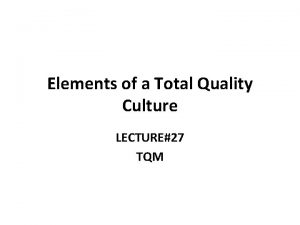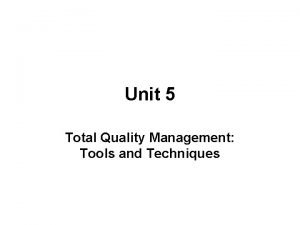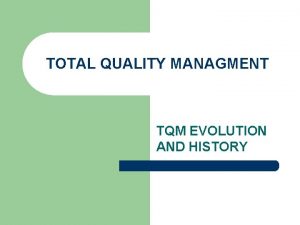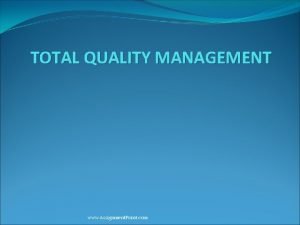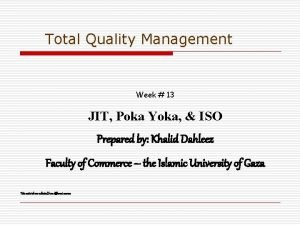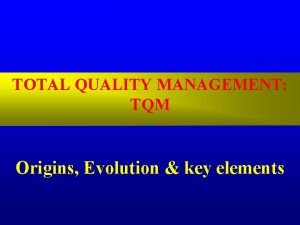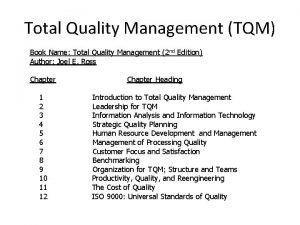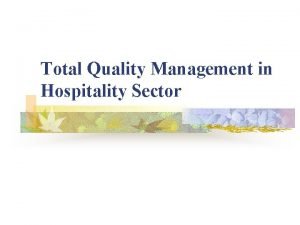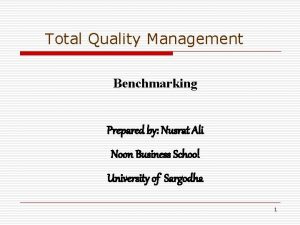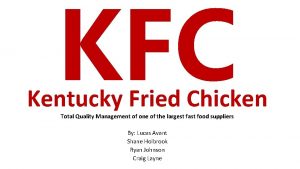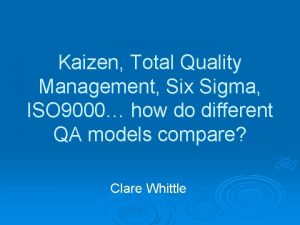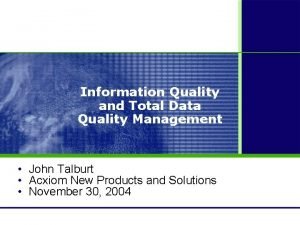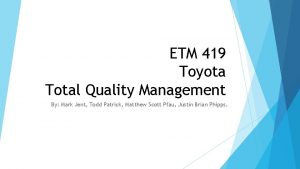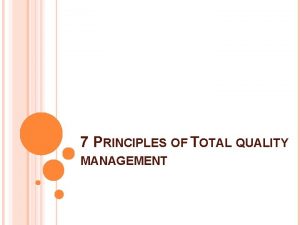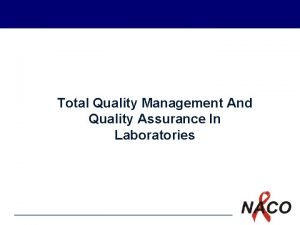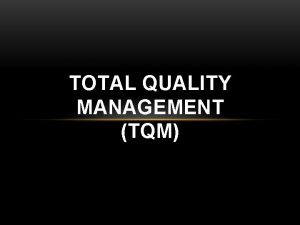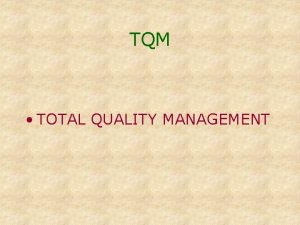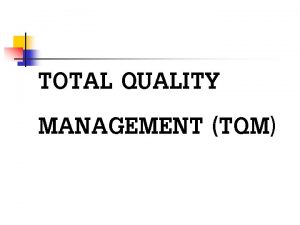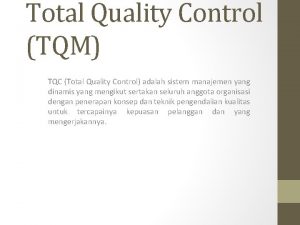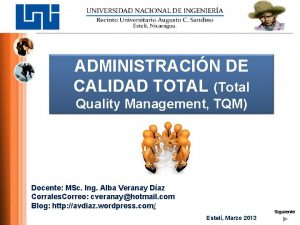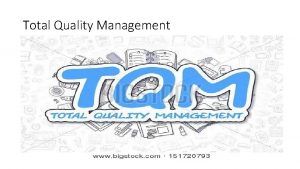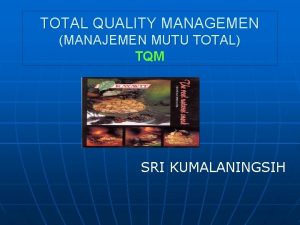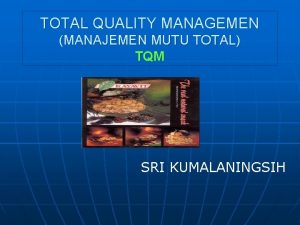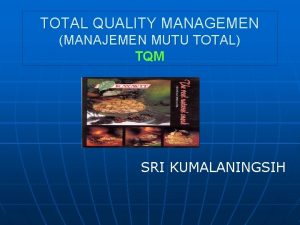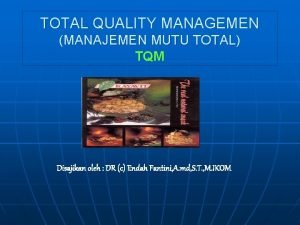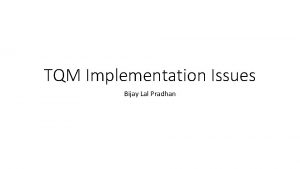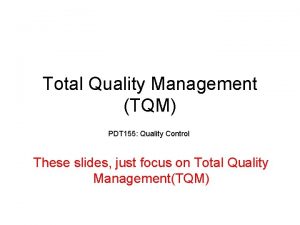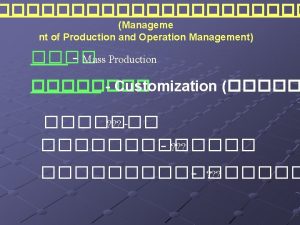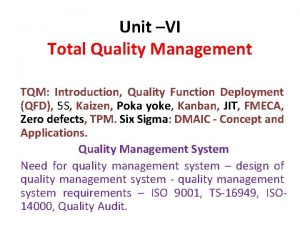Lec5 Project Quality Management Total Quality Management TQM



















![Baldridge Performance Excellence Award From: Baldrige Performance Excellence Program [mailto: baldrigeprogram@nist. gov] Sent: Tuesday, Baldridge Performance Excellence Award From: Baldrige Performance Excellence Program [mailto: baldrigeprogram@nist. gov] Sent: Tuesday,](https://slidetodoc.com/presentation_image/6a856765e085981930e3e5c95d4be5f1/image-20.jpg)
- Slides: 20

Lec#5 Project Quality Management Total Quality Management (TQM) Ghazala Amin

People and Quality Management • Management defines type and amount of work • Management is 85% responsible for quality • The employee can only assume responsibility for meeting the requirements of completing the work when the employee: – Know what’s expected to meet the specifications – Know how to perform the functions to meet the specifications – Has adequate tools to perform the function – Is able to measure the performance during the process – Is able to adjust the process to match the desired outcome 2

Employee Empowerment • Getting employees involved in product & process improvements – 85% of quality problems are due to process & material • Techniques © 1995 Corel Corp. – Support workers – Let workers make decisions – Build teams & quality circles 3

People and Quality Management • Project quality team consists of: – – – Senior Management Project Manager Project Staff Customer Vendors, suppliers, and contractors Regulatory Agencies • Project Manager has the ultimate responsibility for Quality Control and Quality Assurance. • Customer sets the requirement for acceptable quality level. 4

People and Quality Management • Reviews & Audits – Management reviews determine the status, progress made, problems, and solutions – Peer reviews determine whether proposed or completed work meets the requirements – Competency center reviews are used to validate documentation, studies, and proposed technical solutions to problems. – Fitness reviews and audits determine the fitness of a product or part of a project. (addresses specific issues) 5

Total Quality Management (TQM) • Total Quality Management (Department of Defense) – Quality is key to maintain level of readiness – Quality is vital to our defense, requires a commitment by all personnel – Quality is a key element of competition 6

Total Quality Management (TQM) • Total Quality Management is; – an ever improving system for integrating various organizational elements into design, development and manufacturing efforts, providing cost-effective products or services that are fully acceptable to the customer. • Externally; – TQM is customer oriented and provides , meaningful customer satisfaction. • Internally; – TQM reduces production bottlenecks and production costs, enhancing product quality while improving organizational morale. Reference/Source: Dr. Kerzner’s book, Chapter 23 7

Ways in Which Quality Can Improve Productivity Sales Gains – Improved response – Higher Prices – Improved reputation Improved Quality Reduced Costs Increase d Profits – Increased productivity – Lower rework and scrap costs – Lower warranty costs 8

Flow of Activities Necessary to Achieve Total Quality Management • Organizational Practices • Quality Principles • Employee Fulfillment • Customer Satisfaction 9

Organizational Practices • Leadership • Mission statement • Effective operating procedure • Staff support • Training Yields: What is important and what is to be accomplished 10

• • Quality Principles Customer focus Continuous improvement Employee empowerment Benchmarking – It involves comparing actual or planned project practices to those of other projects (either within the performing organization or external) to generate ideas for improvement and to provide a standard by which to measure performance. • Just-in-time • Tools of TQM Yields: How to do what is important and to be accomplished 11

Employment Fulfillment • Empowerment – empowerment requires workers to assume greater responsibility • Organizational commitment Yields: Employees’ attitudes that they can accomplish what is important and to be accomplished 12

Customer Satisfaction • Winning orders • Repeat customers Yields: An effective organization with a competitive advantage 13

TQM: A Project Management approach » Total Quality management can be defined as: » Providing customer with right product at the right time and right place. » Meeting or exceeding customer requirements and/or expectations. » Less wastage and rework to satisfy the customers. 14

TQM: Primary strategies » Primary strategies to achieve Total Quality Management: ● Solicit ideas for improvement from employees. ● Encourage and develop teams to identify and solve problems. ● Encourage team development for performing operations and service activities resulting in participative leadership. ● Benchmark every major activity in the organization to ensure that it is done in the most efficient and effective way. ● Utilize process management techniques to improve customer service and reduce cycle time. ● Develop and train customer staff to be entrepreneurial and innovative in order to find ways to improve customer service. ● Implement improvements so that the organization can qualify as an ISO 9000 supplier 15

TQM: Secondary strategies » Secondary strategies to achieve Total Quality Management: ● Maintain continuous contact with customers; understand anticipate their needs. ● Develop loyal customers by not only pleasing them but by exceeding their expectations. ● Work closely with suppliers to improve their product/service quality and productivity. ● Utilize information and communication technology to improve customer service. ● Develop the organization into manageable and focused units in order to improve performance. ● Utilize concurrent or simultaneous engineering. 16

TQM: Objectives and focus areas 17

Malcolm Baldridge National Quality Award (1987) » The Malcolm Baldrige National Quality Improvement Act was established in 1987. » Purpose of the act was to promote quality awareness; to recognize quality achievements of U. S. companies, and to publicize successful quality strategies. » Award is presented to companies that achieve world-class competition through quality management of products and services. 18

Malcolm Baldridge National Quality Award (1987) » Malcolm Baldridge Award criterias include; » Leadership » Strategic planning » Customer and market focus » Information and analysis » Human resource development and management » Process management » Business results » IBM, General Motors, Corning Glass, Xerox, Kodak, Federal Express, Ritz Carlton etc. 19
![Baldridge Performance Excellence Award From Baldrige Performance Excellence Program mailto baldrigeprogramnist gov Sent Tuesday Baldridge Performance Excellence Award From: Baldrige Performance Excellence Program [mailto: baldrigeprogram@nist. gov] Sent: Tuesday,](https://slidetodoc.com/presentation_image/6a856765e085981930e3e5c95d4be5f1/image-20.jpg)
Baldridge Performance Excellence Award From: Baldrige Performance Excellence Program [mailto: baldrigeprogram@nist. gov] Sent: Tuesday, October 05, 2010 1: 50 AM Subject: New Names for a New Era We are pleased to announce that, effective today, our name is changing from the Baldrige National Quality Program to the Baldrige Performance Excellence Program and the Award name is changing to the Malcolm Baldrige Award. As you know, over the more than 20 years since the inception of the program and the Award, the field of quality has evolved from a focus on product, service, and customer quality to a broader, strategic focus on overall organizational quality. In line with this concept of overall organizational excellence (which some people refer to as “big Q” quality), the Baldrige Criteria have evolved to stay on the leading edge of validated enterprise management practice and needs. This commitment to evolution is a key reason that the Criteria are increasingly seen as the standard for organizational performance excellence worldwide. It is also the reason that the Baldrige Community has embraced “performance excellence” as the term that best reflects who we are and what we do, as indicated in an independent branding study in 2007 that supported the changing of the Award and Program names. With this in mind, the Obama Administration and our Congressional oversight committee made the name changes a part of an overall C realignment that takes place this month. The public announcement of the realignment takes place today, so we are pleased to announce the new names to you and other program stakeholders. In the coming days, weeks, and months, you will see our new names appearing on our Website, in our publications, and in other public communications. To learn more about the name change, please visit us at links. govdelivery. com/track? type=click&enid=b. WFpb. Glu. Z 2 lk. PTEw. Mj. U 1 ODcmb. WVzc 2 Fn. ZWlk. PVBSRC 1 CVUwt. MTAy. NT U 4 Ny. Zk. YXRh. Ym. Fz. ZWlk. PTEw. MDEmc 2 Vya. WFs. PTEy. Nz. Y 2 Mzcx. NDIm. ZW 1 ha. Wxp. ZD 1 y. YXph. Lmto. YW 5 Ac 2 Vjc. C 5 nb 3 Yuc Gsmd. XNlcmlk. PXJhem. Eua 2 hhbk. Bz. ZWNw. Lmdvdi 5 way. Zmb. D 0 m. ZXh 0 cm. E 9 TXVsd. Gl 2 YXJp. YXRl. SWQ 9 Ji. Ym&&&100&&& http: //www. nist. gov/baldrige. If you have any questions, feel free to contact us at baldrige@nist. gov or 301 -975 -2036. Sincerely, The Outreach and Communications Team Baldrige Performance Excellence Program 20
 Supply chain management and total quality management ppt
Supply chain management and total quality management ppt What is tqm
What is tqm Quality gurus
Quality gurus Quality culture in tqm
Quality culture in tqm Total quality management tools and techniques
Total quality management tools and techniques Evolution of tqm
Evolution of tqm Definisi tqm
Definisi tqm Definition of just in time
Definition of just in time Total quality managment
Total quality managment Total quality management 14 points
Total quality management 14 points Ali akao dan mutu
Ali akao dan mutu Tqm book
Tqm book Tqm exemplary organization
Tqm exemplary organization Benchmarking in total quality management
Benchmarking in total quality management Process of nursing audit
Process of nursing audit Tqm of kfc
Tqm of kfc Kaizen total quality management
Kaizen total quality management John talburt
John talburt Quality management toyota
Quality management toyota 7 principles of quality management
7 principles of quality management Total quality management in laboratory
Total quality management in laboratory



